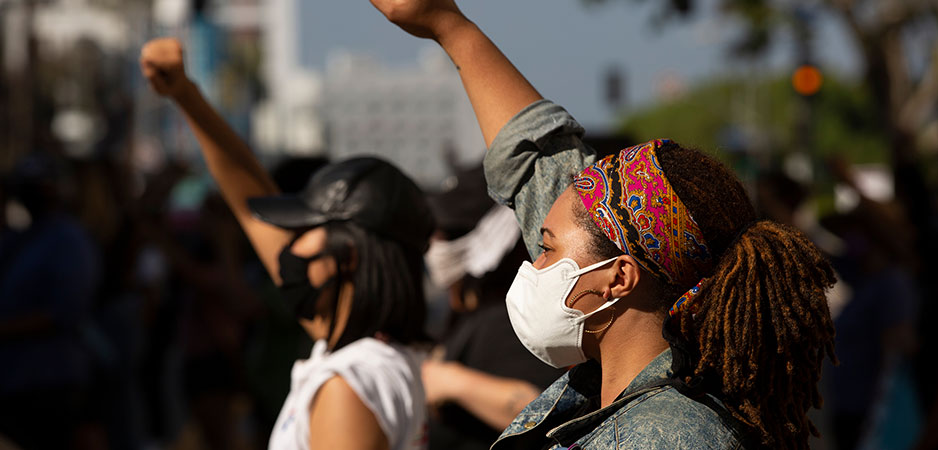“If you had to choose a time to be, in the words of Lorraine Hansberry, young, gifted, and black in America, you would choose right now,” Barack Obama told a graduating class at Howard University in Washington DC four years ago, drawing attention to Hansberry’s 1996 collection of plays, interviews and letters that bore a similar title to the 1970 hit record by Bob and Marcia, written by Nina Simone and Weldon Irvine. It was 2016, and the then-president of the United States advised that the country was, by every criterion, better than when he was a student in the 1960s — a period when the equal rights and social justice movements emerged in the modern era.
Obama may well have been speaking from the heart, but it was hard to square with events. Two months after his speech, five police officers in Dallas were killed in response to two incidents in which black men were shot dead by police. Any rational analysis of race relations in the US in the mid-1960s would have concluded that the crucial and inimical role racism had played in the history of America for the previous 400 years or more was bound to diminish. And Obama was probably right in a sense: It had diminished since the enactment, in 1964 and 1965, of legislation that outlawed discrimination. But racism had not disappeared; there were many loose ends left to untangle.
Rosy Image of US Equality Glosses Over Systemic Racism
America has a long history of white resentment. Resentment, that is, of what most people regard as progress, advancement, illumination, awakening, sophistication and open-mindedness. This might have been intelligible in 1955, when 14-year-old Emmett Till was killed by white men who spotted him talking to a white woman and responded by beating him, gouging out an eye, shooting him in the head, trying a cotton gin around his neck with barbed wire and throwing him in the Tallahatchie River, in Money, Mississippi — a place that features in Bobbie Gentry’s song “Ode to Billie Joe.”
Monstrous, but intelligible: America was racially segregated, and bigotry was real, remorseless and easily reconcilable with the way of life in the South. But the specter of Emmett Till loomed large and didn’t vanish with the onset of civil rights — it continued to haunt the modern era.
Living Pestilence
Uprisings following the death of George Floyd, an unarmed black man, at the hands of Minneapolis police began peacefully last week, but escalated into arguably the most serious expressions of rage since the 1960s. The catalyst was the same one that precipitated the Till killing: racism. America has had its fair share of problems to deal with over the years, but none compares to the racism that has bedeviled the nation for its entire history.
Time and again, resolutions have been approached, and yet, over four hundred years since a group of about one hundred settlers founded the first English settlement in North America and called it Jamestown, none has ever been achieved. Every time a new milestone is reached — whether it is unflinching legislation or a black president — America is barbarously reminded that its slave past has never truly been consigned to history.
“Last night … was an ugly night all across the nation,” said Andrew Cuomo, New York’s governor, over the weekend. “The real issue is the continuing racism in this country and it is chronic and it is endemic and it is institutional.” Endemic and institutional: His choice of terms is revealing. It suggests racism, like the coronavirus that now menaces the planet, is a condition that is regularly found and is bound to reappear. It is also incorporated into the repeated patterns of behavior rather than being the exclusive preserve of one particular group. In fact, it has become so routine that we barely notice racist activities simply because they are so familiar. Even when we do notice, racism has a virus-like way of surreptitiously reentering our ecosystem. Think: #BlackLivesMatter and #OscarsSoWhite are both recent reminders that racism is not a relic, but a living pestilence.
And yet here we are: Another unarmed black man dead at the hands of a white police officer. Were this one incident in an era otherwise unmutilated by racist incidents, it would still be an occasion for serious reflection and soul-searching as well as an opportunity for police reform. But it is far, far from an isolated incident.
On a March night in 1991, four Los Angeles policemen were filmed by an unseen onlooker brutally beating a man pulled over for a traffic violation. The police officers were white, while Rodney King was African American. It was probably the kind of incident that happened routinely in this and many other parts of the world. But the presence of an unseen third party weaponized with a video camera transformed this into something unexpected. The actual footage is still viewable.
When the case against the police went to court in April 1992, the judge ordered an unusual change of venue for the trial to a predominantly white suburb. The officers were cleared on all but one charge by a jury comprising 10 whites, one Asian and one Latino — no African Americans. Violent protest against the apparent lack of justice spread across the nation for four days. The Rodney King riots, as they became known, left the US stunned, though not changed forever.
Exposé of Violence
Although no one knew it at the time, the Rodney King riots were the start of a new narrative that would take shape over the next three decades. “This is America,” screamed many in disbelief. The 1992 uprisings were the first meaningful signs of racial unrest since the civil rights era. But it was only a start.
Only two months after the rioting, a 35-year-old black motorist Malice Green was beaten by Detroit police officers and later died from the injuries. Two police officers were convicted of second-degree murder, both later reduced to the less serious charge of involuntary manslaughter. In 1997, Abner Louima, a 33-year-old Haitian immigrant, was arrested for interfering with officers trying to break up a fight. Police officers were charged and convicted of beating and torturing him and, later, for obstructing justice by covering up the crime.
But perhaps the most extraordinary exposé of violence and racial injustice came on February 4, 1999, when a 23-year-old West African street trader named Amadou Diallo stepped out from his apartment in the Bronx. He encountered four plainclothes NYPD officers who opened fire, discharging 41 shots and killing Diallo instantly. Their defense was that they thought Diallo was reaching for a gun whereas he was pulling out his wallet to show ID.
Diallo’s death said all anyone needed to know about how cosmetic the so-called colorblind society actually was. Sean Bell and Eric Garner in New York, Michael Brown in Ferguson, Missouri, Ahmaud Arbery in Georgia: These are just a few of the victims that form part of a grim litany. Garner’s dying words, “I can’t breathe,” were uttered by Floyd and have once more become the slogan of an international protest. Amnesty International came up with its own slogan to capture the long, repetitive history, “Another Year, Another Unarmed Black Man Killed by Police.” It used this as its headline for a report on the anniversary funeral of Oscar Grant, who was killed by police officers in Oakland, California, in 2009.
Is Floyd’s death different? No. But the response appears to be. Perhaps the world is perversely united by a common interest in extirpating COVID-19 at the moment. If so, its population is vigilantly watching any kind of event in the United States. America’s intractable racial inequality is no secret, but Floyd’s death has turned it into headline news everywhere. People are hurting. Their loved ones are dying. They are losing their jobs, their businesses and, in many cases, their houses because of an unseen malefactor. They can empathize with others who are victimized by a different type of evildoer, this time visible from anywhere on earth.
Obama’s upbeat remark was probably right at the time. In 2016, he was leaving office and, in the eyes of many, the US was in good shape. Having an African American in charge for eight years was sure to have an impact in every conceivable corner of society — or so we all thought. When he came to power in 2009, Obama was exalted as the man who would change America and perhaps guide it toward being a colorblind society. His replacement by a man who appears retrogressive in his approach to racism has shifted the needle back.
Last August, following the mass shootings at El Paso, Texas, Trump was accused of giving aid and comfort to white supremacists, stirring up conflict and intensifying racial hatred. Even if you set opinions aside and rely on bare facts, there is plausible data that suggests anti-immigrant sentiment and xenophobia, as well as racism and sexism, are strongly related to support for Trump. It would be unwise and inaccurate to lay the blame solely at Donald Trump’s feet. But the president sets the tone for the nation, and support for his 2016 campaign was driven by racism. We will know later this year if he still enjoys much of that support.
It is no longer a good time to be young, gifted and black. It is a perilous time.
*[Ellis Cashmore is the author of “Beyond Black: Celebrity and Race in Obama’s America.”]
The views expressed in this article are the author’s own and do not necessarily reflect Fair Observer’s editorial policy.
Support Fair Observer
We rely on your support for our independence, diversity and quality.
For more than 10 years, Fair Observer has been free, fair and independent. No billionaire owns us, no advertisers control us. We are a reader-supported nonprofit. Unlike many other publications, we keep our content free for readers regardless of where they live or whether they can afford to pay. We have no paywalls and no ads.
In the post-truth era of fake news, echo chambers and filter bubbles, we publish a plurality of perspectives from around the world. Anyone can publish with us, but everyone goes through a rigorous editorial process. So, you get fact-checked, well-reasoned content instead of noise.
We publish 2,500+ voices from 90+ countries. We also conduct education and training programs
on subjects ranging from digital media and journalism to writing and critical thinking. This
doesn’t come cheap. Servers, editors, trainers and web developers cost
money.
Please consider supporting us on a regular basis as a recurring donor or a
sustaining member.
Will you support FO’s journalism?
We rely on your support for our independence, diversity and quality.






